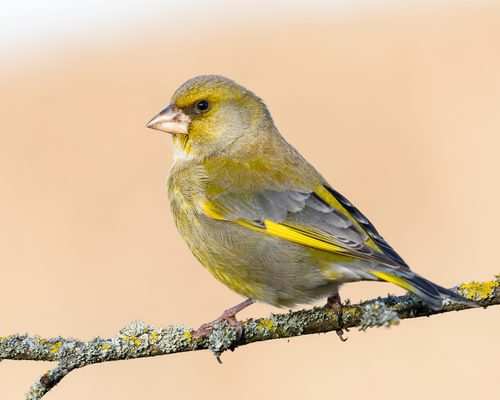While male greenfinches flaunt their yellow-green finery, their female counterparts rely on subtlety – a masterclass in understated elegance that many birdwatchers overlook.
Distinguishing between the sexes requires a keen eye, but the rewards include a deeper appreciation for these common UK garden visitors.
Key Identification Features
Female greenfinches wear a more muted olive-green plumage compared to the bright yellow-green of males. This difference is most pronounced during spring and summer. The contrast is immediate when both sexes visit garden feeders together – males appear distinctly yellowish, especially on the face and breast, while females show a more uniform olive-brown tone.
Look for these key differences:
Wing bars – Both sexes display wing bars, but females are more subdued and greyish-yellow rather than the bright yellow bars visible on males.
Head and face – Males have noticeably yellow faces, particularly around the eye and forehead. Females lack this bright facial colouration, showing a more consistent olive-grey head pattern.
Underparts – Female greenfinches have more streaking on their flanks and a duller, greyish belly. Males show brighter yellow tones, especially on the breast and lower belly.
Despite these differences, males and females share the same chunky build, heavy pale bill, and distinctive silhouette that separates greenfinches from other garden finches.

Close up of a female Greenfinch, perched on a branch
Seasonal Changes
Identifying female greenfinches becomes easier during spring and early summer when males are at their brightest. The breeding season amplifies their differences, with males developing more vibrant yellow tones while females remain subtly olive-green.
Winter presents more of a challenge. Males become somewhat duller after their autumn moult, reducing the contrast between the sexes. Even then, careful observation reveals males retain more yellow in their plumage than females.
A late summer garden scenario often includes recently fledged juveniles, which closely resemble females regardless of their sex. Young birds display heavier streaking on their bodies, gradually developing adult plumage after their first moult.

Close up of a female Greenfinch
Behaviour and Habitat
Both male and female greenfinches share identical feeding habits and flight patterns. Their characteristic bouncy, undulating flight and strong, direct movements at feeders provide no clues to their sex.
However, during the breeding season, males become more vocal, regularly issuing their distinctive wheezing "dzweee" calls from prominent perches, while females remain relatively quiet.
In UK gardens, greenfinches strongly favour seed feeders – particularly those stocked with sunflower hearts and black sunflower seeds.
Both sexes display similar levels of assertiveness when feeding, despite the female's less showy appearance. They vigorously defend feeding positions from other birds, using their robust bills to crack seeds efficiently.

Male (left) and female (right) Greenfinches together at a bird feeder
Where to Spot Female Greenfinches in the UK
Female greenfinches occur throughout mainland Britain and Ireland year-round. Garden feeding stations provide excellent observation opportunities, particularly in suburban areas with nearby hedgerows or conifers for nesting.
Parks, woodland edges, and farmland with hedges also attract greenfinches, with females becoming more secretive during the nesting period (April to August).
During autumn and winter, mixed feeding flocks offer good chances to compare males and females side by side as they forage on seed heads and berries.

Female Greenfinch gathering nesting material
Common Confusion Points
Unlike some bird species where females appear predominantly brown, female greenfinches retain olive-green tones throughout their plumage. Their colouration represents a muted version of the male pattern rather than a completely different palette.
Another misconception involves size – males and females share identical proportions (length 15cm, wingspan 26cm), with no reliable size difference for identification purposes.
Young birds present the greatest identification challenge, as juvenile males closely resemble adult females until they develop their brighter adult plumage. By late autumn, most juveniles have moulted into more recognisable adult plumage.

Female Greenfinch feeding on sunflower seeds
Quick Reference Guide
For quick field identification between male and female greenfinches:
- Female: Overall olive-green/brown, muted wing bars, uniform head colouration, more streaking on flanks
- Male: Brighter yellow-green, especially on face and breast, bright yellow wing bars, yellower underparts
- Best observation time: Spring and early summer when differences are most pronounced
- Best locations: Garden seed feeders, especially those offering sunflower hearts
Female greenfinches might lack their partner's flashy appearance, but their subtle beauty and identical ecological role make them equally fascinating members of the UK's garden bird community. With practice, distinguishing the sexes becomes an enjoyable part of backyard birdwatching.

